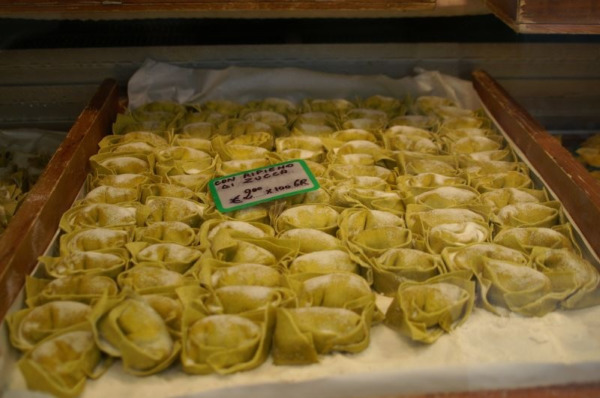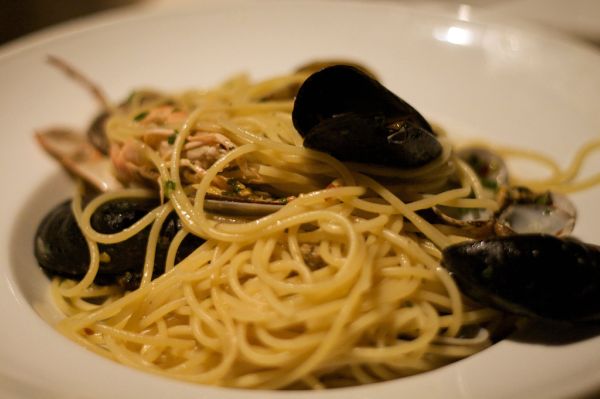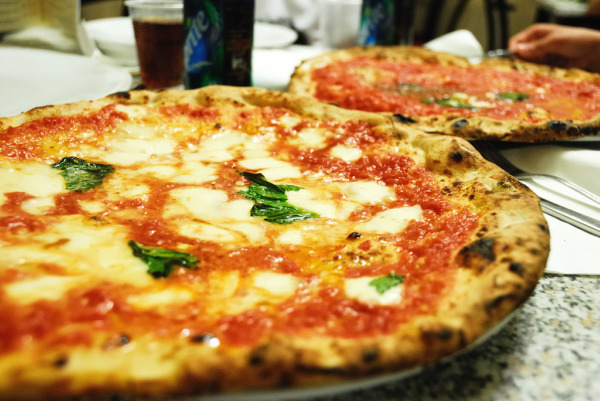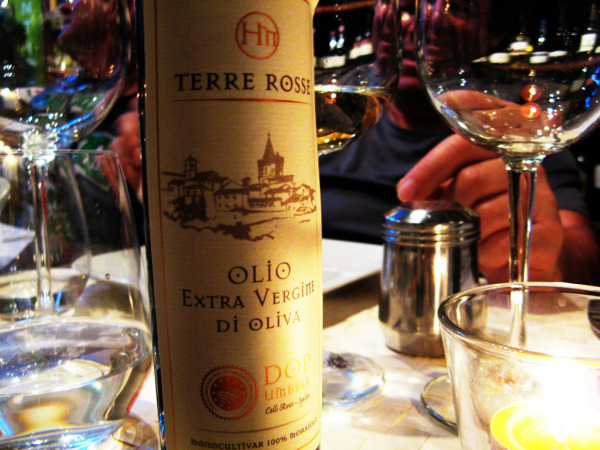Italian Food
Others may dispute this, but I happen to think Italy is the food capital of the world. Italians, I think, would back me up on this. And really, whether or not you agree doesn’t change the fact that millions of people visit Italy every year to satisfy a hunger for more than just Renaissance art.
While non-Italians tend to think of “Italian food” as one homogeneous menu, that couldn’t be further from the truth. Italy is intensely regional, and a dish considered one city’s signature will be unheard of 100km (or less) down the road. This is one of the many reasons why ordering a good restaurant’s daily special is a great way to sample what’s truly local.
But we’ll get to that.

photo by Jessica Spiegel and may not be used without permission
Italian food is a subject I’m passionate about, so I’ve written quite a bit about it on WhyGo Italy. In an effort to help you avoid getting lost among the food articles (there are worse ways to go, I’ll admit), I’ve tried to organize this page into a sort of “table of contents” (no pun intended) of the Italian food subject on the site. I’ll continue to update it as I write more articles on the subject, and keep an eye on the menu to the right for links to the best articles about food in Italy.
The sections you’ll find below are (click on each link to jump to that section):
Italian Food 101

photo by Julien Menichini
Italian Food is Simple
Perhaps the thing that makes Italian food so appealing the world over, both to those who eat it and those who make it, is the focus on high-quality, seasonal, regional ingredients – and the simplicity of the recipes.
You’ll sometimes hear that every great Italian dish has only three ingredients, and while that’s often not true, you won’t find complicated dishes in most of the country’s family restaurants. Instead of complex combinations of ingredients or fussy processes, Italians choose instead to use the best fresh ingredients they can find – meaning what’s in season and available locally – and then not screw them up by adding a bunch of extras.
This means that no matter what kind of restaurant you’re eating in, as long as it’s not one set up just for tourists you’re likely to eat well.

photo by Fermented Thoughts
Italian Food is Regional
As mentioned above, Italian food is very regional. There are special dishes that are unique to one town or a small collection of nearby towns that you can’t find anywhere else. And because each of Italy’s regions has specialties which will only be found there, it’s impossible to really list all of the things to look for in each region here. And such an exercise would be pointless, anyway, because someone else has already done it.
The book I never leave home without when I’m going to Italy is The Hungry Traveler: Italy by Pat Mozersky. This pocket-sized guide is jam-packed with all the information a foodie in Italy needs, even if you don’t speak a word of Italian. There’s an alphabetical menu guide, tips for shopping in Italian markets, and a section listing specialties by region and season. It’s been invaluable to me, and I highly recommend it to every traveler I talk to.
Update: Mozersky’s book is now out of print, so if you happen upon a copy in a used bookstore somewhere you should snap it up immediately. There isn’t a great alternative out there, but the Marling Menu Master: Italy at least covers the menu decoder portion of Mozersky’s book.

photo by dawvon
Italian Food is Not What You Think
Because there are Italian restaurants all over the world, many foreign visitors in Italy think they know what “Italian cuisine” is as soon as they arrive. They walk into restaurants expecting “peperoni pizza” to be pizza with spicy cured sausage slices on it (and wondering why it’s missing one ‘p’ on the menu). They think spaghetti always comes with meatballs. And they can’t believe no restaurant menu they look at has the famous fettucine Alfredo on it.
If you don’t know what’s wrong with the three examples I just listed, then you need to keep reading. (For a quick lesson, those three misconceptions are explained at the bottom of this page.)
As you’ve already learned from what you’ve read so far, Italian food isn’t one big menu available throughout the country. But what’s more, it’s likely to be quite unlike the Italian food you’ve gotten used to eating back home. The Olive Garden is absolutely not Italian food. It’s Italian-American at best. If you like the Olive Garden, that’s fine – but you can’t expect Italian food in Italy to be like the Olive Garden, or you’ll be sorely disappointed and potentially upset the Italians who are cooking for you.
Italians take their food very seriously. As a guest in their country, it’s only polite to do the same.

photo by Jessica Spiegel and may not be used without permission
Italian Food Terminology
Luckily, many of the words you’ll see on menus in Italy will be familiar to you. I used to tell my Italian language classes that you can be pretty sure you won’t starve in Italy, even if you’re afraid to talk to anyone but the waiter. But here are a few articles that may help you sound like you know what you’re talking about when it comes to food in Italy:
- Menu Tips for Italy – This brief article will help guide you through an Italian menu, but scroll back up the page a bit to find the book I recommend every traveler bring with them (it includes an outstanding menu guide)
- Italian Pasta Names – There are more than 350 different kinds of pasta in Italy; this article lists a selection of popular varieties
- Italian Coffee 101 – Order like a pro from this list of coffee drinks in Italy (and some non-coffee options at the bar, too)
- Italian Gelato Flavors – I always say you should have gelato every day in Italy; this article will help you diversify your flavor choices
- Tipping in Italy – Whether or not to tip is a question travelers always forget to look up the answer to until they’re staring at a bill; this article has what you need to know about whether to tip in Italy (and here’s a bonus article on what that “service charge” listed on menus actually covers)

photo by Randy OHC
How to Eat Well in Italy
I realize not everyone who visits Italy considers “eating” a pastime. You may not want to spend your precious vacation time sitting in a cafe for a two-hour lunch, and you cringe at the idea of spending more than €50 on a nice meal for two. For me, great meals are some of my favorite souvenirs, even though they don’t leave me with anything to pack in a suitcase or display on a shelf. Still, I know not everyone is like me.
The good news is that you don’t have to be willing to spend a fortune to eat well in Italy, and you don’t have to linger for hours over a meal, either. I will still strongly encourage you to avoid restaurants where the menu is translated into several languages, there’s a waiter standing outside the front door trying to lure people in, or there’s a big golden arches logo on the door. Yes, there’s fast food all over Italy, and it’s reliable for a quick (and cheap) meal of exactly what you’d expect it to be. You’ll typically find lots of Italians there, too. And I’d still tell you to stay away.
With a little know-how, anyone can step outside their translated-menu or fast food comfort zone and enjoy great and simple food in Italy that’s inexpensive and delicious. Here are some articles that will help you on this path:
- Different Kinds of Restaurants in Italy – This article helps decode the difference between a “trattoria” and an “osteria,” and a “ristorante” and a “bar”
- How to Find Good Gelato in Italy – There are bad gelato places, and there’s no sense in wasting any valuable stomach real estate on gelato that’s not sublime
- How to Order Gelato in Italy – After you’ve found the good stuff, here’s what you need to know to get some (because the rules can differ from place to place)
- Eating Cheap in Italy: Aperitivo – Sort of like happy hour, “aperitivo” is increasingly popular (especially in Italian cities) and can be a fun way to eat well and very cheaply
If your mouth is already watering at the prospect of eating in Italy and you’re not afraid to abandon your old ideas of Italian food in favor of what the Italians are serving, then here are some articles foodies traveling in Italy will find useful in planning trips:
- Home Food – Through the Home Food program, travelers can sign up to eat a meal in a real Italian home
- Italian Market Guide – Shopping in Italy’s food markets is fun, whether you’re picking up picnic items for a quick and cheap meal or filling the cupboards of your apartment rental
- Cooking Schools in Italy – For those who aren’t content letting someone else cook all that fabulous food
>> I didn’t write this, but I think it’s handy – a list of the different kinds of stores where you’ll shop for food (and other necessities) if you’re renting an apartment in Italy, and even a suggested shopping list for that first trip to the store.

photo by Jessica Spiegel and may not be used without permission
WhyGo Italy Recipes
I’ve posted a few recipes over the years here on WhyGo Italy – a few of them are recipes I make, and others come from my Italian foodie friends. Here are links to all the Italian classics you can make at home:
- Strawberry Gelato Recipe
- Limoncello Recipe
- Chocolate Gelato Recipe
- Italian Lentil Soup Recipe
- Fried Zucchini Flowers Recipe
- Pasta alla Carbonara Recipe
- Tiramisu Recipe

photo by sporkist
Italian Food Misconceptions: The Answers Revealed
If you’ve read through this whole article, you’ll remember the three Italian food misconceptions that I listed above under “Italian Food is Not What You Think.” Don’t feel badly if you didn’t understand all of them – they’re popular misconceptions, and you’re not alone. Here they are, with explanations:
- Why does my ‘peperoni pizza’ not have sausage on it? And hey, why is there only one ‘p’ in the word? – As you’ve probably guessed, peperoni doesn’t mean what you think it means. With two Ps, it’s spicy sausage that’s thinly sliced and one of the most popular pizza toppings outside Italy. With one P, it’s the Italian word for “peppers.” So that “peperoni pizza” you ordered will come covered with peppers. Want something like the cured sausage you love back home? Then you’ll want to order salame piccante (hot salami slices).
- Where’s the spaghetti and meatballs on this menu? – Spaghetti and meatballs is an Italian-American creation, and although there are pasta sauces that have meat in them, Italians tend to eat the meat course separately from the pasta course. Which means big meatballs wouldn’t do on a plate of pasta. The Italian word for meatball is polpetta, and you’ll sometimes see it as a meat course (with no pasta in sight).
- Why did the waiter look at me funny when I asked about Alfredo sauce? – Yes, Alfredo sauce comes from a chef named Alfredo who named the dish after himself, but he neither invented it nor popularized the name in Italy. In Italy, the “sauce” in question is simply melted butter and a little bit of parmigiano mixed with otherwise plain pasta. It’s the Italian equivalent of Saltine crackers and ginger ale – what my mother always gave me when I had an upset stomach. And I don’t expect to find “Saltine crackers and ginger ale” on any menu. Italians still eat this simply-dressed pasta, most often when they’re ill, and they call it pasta in bianco or pasta al burro, depending on where you are, for “white pasta” or “pasta with butter.” But you’ll understand now why you won’t find it on a menu. Incidentally, the article “Who is Alfredo Sauce, and why do Americans keep asking about him?” is an excellent read on the subject, both funny and educational.
Because I love food, I have a tendency to write about Italian food quite a bit on WhyGo Italy. You can browse through all the posts I’ve written about Italian food if you don’t believe me.
And check out the information about vineyards in Italy, too – even those of us who aren’t even close to being wine snobs can appreciate the history of Italian wine-making!